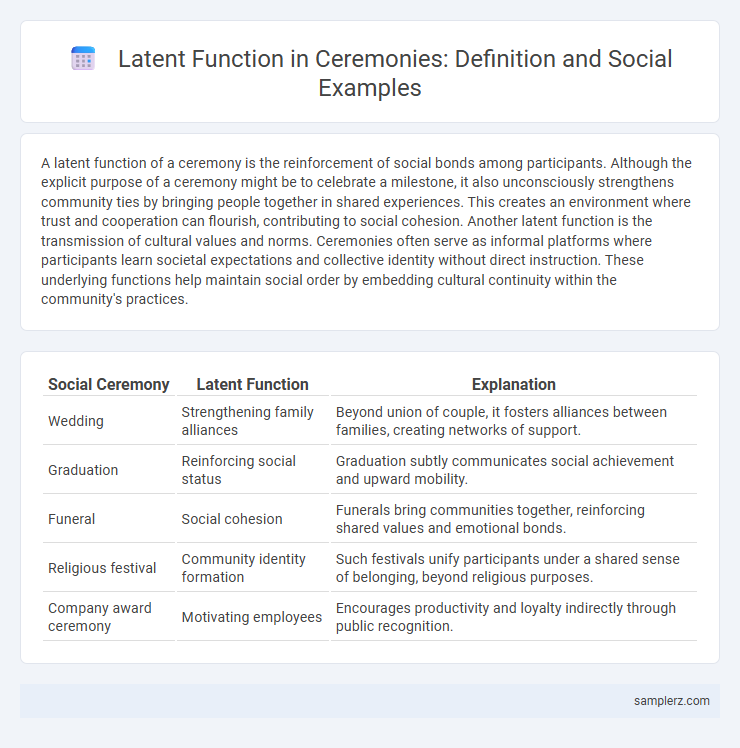A latent function of a ceremony is the reinforcement of social bonds among participants. Although the explicit purpose of a ceremony might be to celebrate a milestone, it also unconsciously strengthens community ties by bringing people together in shared experiences. This creates an environment where trust and cooperation can flourish, contributing to social cohesion. Another latent function is the transmission of cultural values and norms. Ceremonies often serve as informal platforms where participants learn societal expectations and collective identity without direct instruction. These underlying functions help maintain social order by embedding cultural continuity within the community's practices.
Table of Comparison
| Social Ceremony | Latent Function | Explanation |
|---|---|---|
| Wedding | Strengthening family alliances | Beyond union of couple, it fosters alliances between families, creating networks of support. |
| Graduation | Reinforcing social status | Graduation subtly communicates social achievement and upward mobility. |
| Funeral | Social cohesion | Funerals bring communities together, reinforcing shared values and emotional bonds. |
| Religious festival | Community identity formation | Such festivals unify participants under a shared sense of belonging, beyond religious purposes. |
| Company award ceremony | Motivating employees | Encourages productivity and loyalty indirectly through public recognition. |
Unseen Social Bonds: Latent Functions in Ceremonies
Ceremonies often serve latent functions by reinforcing unseen social bonds among participants, fostering a sense of community and shared identity beyond the explicit purpose of the event. These hidden social connections promote social cohesion and trust, which are crucial for maintaining group solidarity in societies. Such latent functions contribute to the durability of social networks and cultural continuity over time.
Strengthening Identity: Hidden Roles of Rituals
Rituals during ceremonies reinforce collective identity by subtly promoting shared values and belonging among participants, often unnoticed. These latent functions create a sense of unity and continuity, strengthening social cohesion beyond the explicit purposes of the event. Such ceremonies embed traditions that sustain cultural heritage while fostering individual and group identity within a community.
Fostering Group Solidarity Through Ceremonial Acts
Ceremonial acts create latent functions by fostering group solidarity, as participants share collective values and reinforce social bonds. Rituals such as weddings or national holidays unite individuals through shared emotional experiences, strengthening group identity and cohesion. These latent functions contribute to social stability by promoting mutual support and cooperation within the community.
Indirect Social Control: Ceremonies as Norm Enforcers
Ceremonies serve as latent functions by indirectly enforcing social norms through ritualized behaviors that reinforce collective values and expectations. By observing ceremonies, participants internalize rules and standards, promoting conformity without explicit coercion. This subtle form of social control maintains order and cohesion within communities by aligning individual actions with societal ideals.
Building Networks: Unintentional Connections in Ceremonies
Ceremonies often serve latent functions by facilitating unintentional social connections and networking opportunities among participants. These events create environments where individuals from diverse backgrounds can interact, fostering new relationships that extend beyond the ceremony itself. Such latent networking functions enhance social cohesion and collaboration within communities.
Maintaining Hierarchies: Subtle Status Reinforcement
Ceremonies often serve a latent function by subtly reinforcing social hierarchies through rituals that emphasize rank and status distinctions, such as seating arrangements, dress codes, and roles assigned during events. These implicit signals maintain existing power structures without overtly stating them, ensuring social cohesion and acceptance of authority. By embedding status cues within ceremonial practices, communities perpetuate hierarchy and influence social behavior.
Facilitating Conflict Resolution: Ceremonies as Peacekeepers
Ceremonies often serve as latent functions by facilitating conflict resolution within communities. Rituals and formal gatherings provide structured environments where grievances can be expressed and addressed, promoting social harmony without overt confrontation. These peacekeeping functions help reinforce social cohesion and maintain group stability over time.
Emotional Release: Unspoken Therapeutic Functions
Ceremonies often serve latent functions such as emotional release, providing participants with unspoken therapeutic benefits that facilitate psychological healing and stress reduction. Rituals like funerals or weddings enable individuals to express and process complex emotions in a socially sanctioned space, promoting mental well-being without explicit dialogue. These implicit emotional outlets contribute to social cohesion and individual resilience within communities.
Legitimizing Change: Ceremonies as Agents of Transition
Ceremonies often serve a latent function of legitimizing social change by symbolically endorsing new roles or statuses within a community, facilitating smooth transitions. For example, a graduation ceremony not only celebrates academic achievement but also legitimizes the transition from student to professional, reinforcing social structures. This latent function helps maintain societal stability by embedding change within recognized rituals.
Preserving Tradition: Ceremonies as Cultural Memory
Ceremonies serve as latent functions by preserving tradition and reinforcing cultural memory, ensuring that collective values and historical narratives are transmitted across generations. These rituals create a shared sense of identity and continuity, embedding social norms and customs within communal practices. By enacting symbolic gestures and storytelling, ceremonies maintain the cohesion and resilience of cultural heritage.

example of latent function in ceremony Infographic
 samplerz.com
samplerz.com